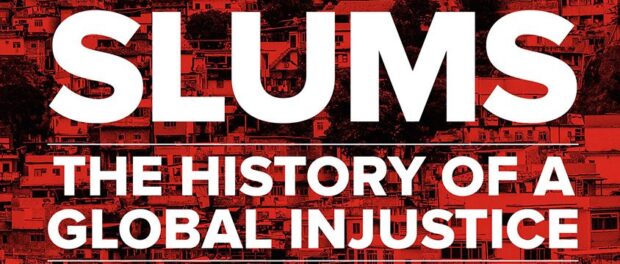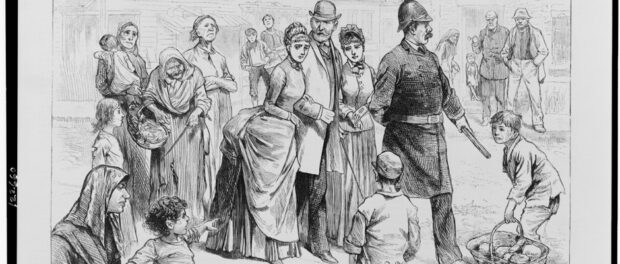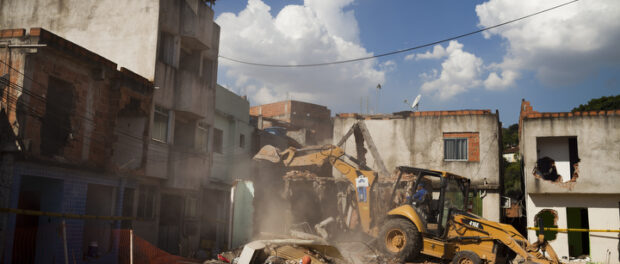
For over two centuries, presiding political, academic, and cultural authorities have classified low-income urban neighborhoods as “slums.” The history of this term and the communities on which it has been imposed extends beyond the places of its original application—namely the tenements of industrial British and American cities—to almost exclusively denote an urban landscape characteristic of the Global South.
In his new book, Slums: The History of a Global Injustice, Australian historian Alan Mayne examines the etymology of the word “slum” and presents the case for removing it entirely from the lexicon of urban policy regimes. The word, Mayne argues, has come to represent a deceitful construct that obfuscates the diverse social, cultural, and economic conditions of cities. Tracing the early applications of the term by reformers and policymakers in the Euro-American context to its later colonial formulation in the Global South, he contends that the word’s history of pathologizing and racializing poverty, as well as disenfranchising residents, has rendered it unsuitable for further use.
A Pathology of Poverty
The word “slum” was first recorded in early nineteenth century London, coinciding with the rapid urban growth of British industrialization. The discussion of “slums,” as Mayne points out, did not originate from residents, but rather among the elite ruling class concerned with the public health and political implications of such densely concentrated poverty. While some discussions centered on the physical precarity of these neighborhoods, which housed the majority of a growing class of industrial factory workers, the emergent discourses pathologized urban poverty from the outset. Early reformers, including those with sincere intentions to improve living conditions, framed the conversation on “slums” around what Mayne describes as an “otherness“—”an imaginary opposite to their own familiar worlds, activities, value systems.” Reformers centered their denunciations of such neighborhoods on the “slum culture” and “slum habits” of residents, suggesting that lifestyles and choices made by residents accounted for the conditions in tenements.
The concept of “slums” and their inherent “otherness” was subsequently transported across the urbanizing English-speaking world, notably to the United States and Australia, where it proceeded to frame conversations on urban policy. This trend materialized in the United States with academic and journalistic coverage of the tenements in New York, both of which relied on tropes and characters that presented residents as unemployable, irresponsible, or helpless. Central to these distortions was the explicit racialization and “orientalization” of urban poverty. This remained the case from 18th-century British cities to 20th-century American cities, where racial prejudice against immigrant and black residents upheld reform agendas advancing policies of renewal and clearance. Mayne contends that “slum deceits” of racial prejudice and personal failures on the part of residents are thus embedded in the term, arguing that planning and policy regimes that frame discussions using the word “slum” further perpetuate these centuries-old distortions.
A Colonial Construct
While slum deceits undergirded some of the most destructive urban interventions in Euro-American cities, the contradiction that Mayne articulates throughout the book is that of the colonial legacy of the slum construct. Urban planning agendas represented central projects of colonial regimes, and the term “slum” and its associated policy prescriptions were exported to African, Asian, and Latin American cities throughout the 19th and 20th centuries. This colonial construct not only survived independence movements across these regions but is now almost exclusively applied to cities in the Global South. Mayne traces the paradoxical trajectories of independence and a reinforced legislative framework of colonial slum clearance practices in India, Kenya, Uganda, Singapore, and Hong Kong, among others.
Mayne found that in most of these countries, “postcolonial leaders, rather than rejecting slum labels as an alien construct that had been artificially imposed by colonialism, adopted slum metaphors to encapsulate the old colonial order that they claimed to be breaking down through democratization and modernization.” This phenomenon was perhaps best illustrated by postcolonial India, which became the first country to elevate slum clearance to the national planning agenda.
In addition to postcolonial governments, the term has maintained relevance among international development agencies, particularly the United Nations and World Bank. These organizations continue to influence planning agendas across the world while promoting a fallacious framework for considering urban poverty, a fact with which Mayne particularly takes issue. “Nowhere was the concept [of slums] organic to the places it described and nowhere was it unreservedly accepted by the inhabitants of these neighborhoods,” he writes. Such was the case in Euro-American cities and remains the case in many cities today. Yet the most influential development organizations continue to promote this term, along with its inherent deceits, despite evolving policy platforms. Both the UN and World Bank have shifted considerably their respective policy recommendations for informal neighborhoods, favoring upgrading and titling initiatives in recent years over previously-touted removal schemes. Such an evolution of policy prescription may warrant a more nuanced discourse.
Implications of Language
Throughout his book, Mayne contends that the persistence of the word “slum” in social policy agendas represents a global injustice. The language employed by English-speaking authorities and institutions has perpetuated a “war on slums” that has endured for centuries and spanned continents. In some of the earliest applications in British cities, debates about “the slum problem” connoted violent struggles between “civilization and savagery.” Over a century later in the United States, the connotation changed little, as over one million households were evicted from neighborhoods condemned as “slums” in efforts to combat blight and the myriad social pathologies associated with such environments. These precedents mirror experiences of removal and criminalization that persist today throughout the Global South.


